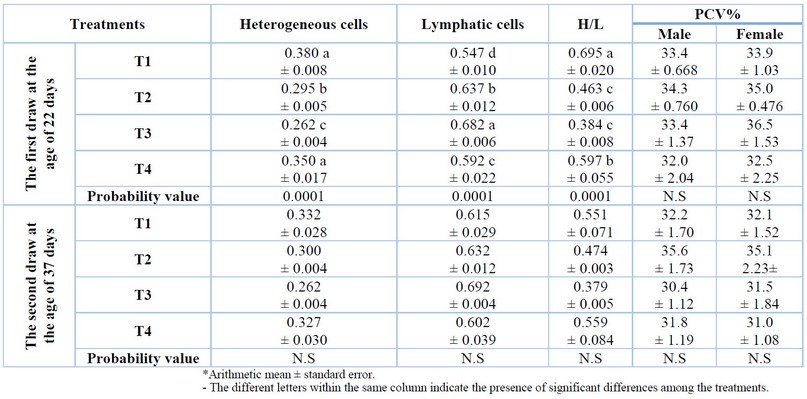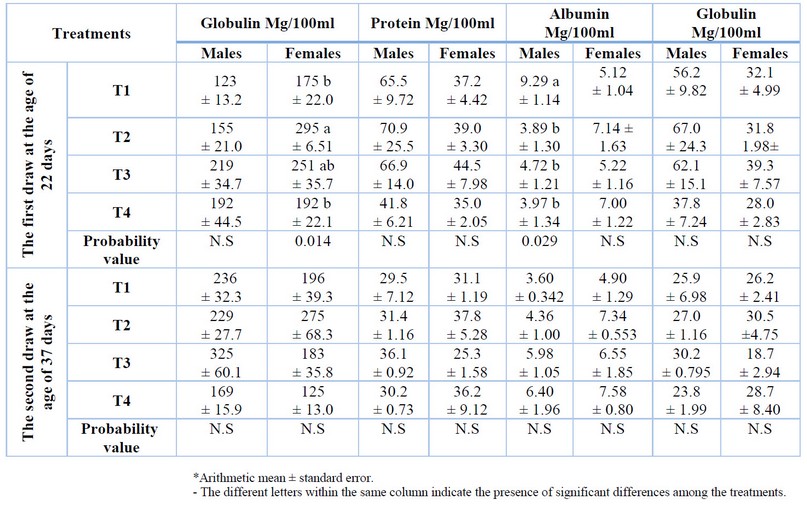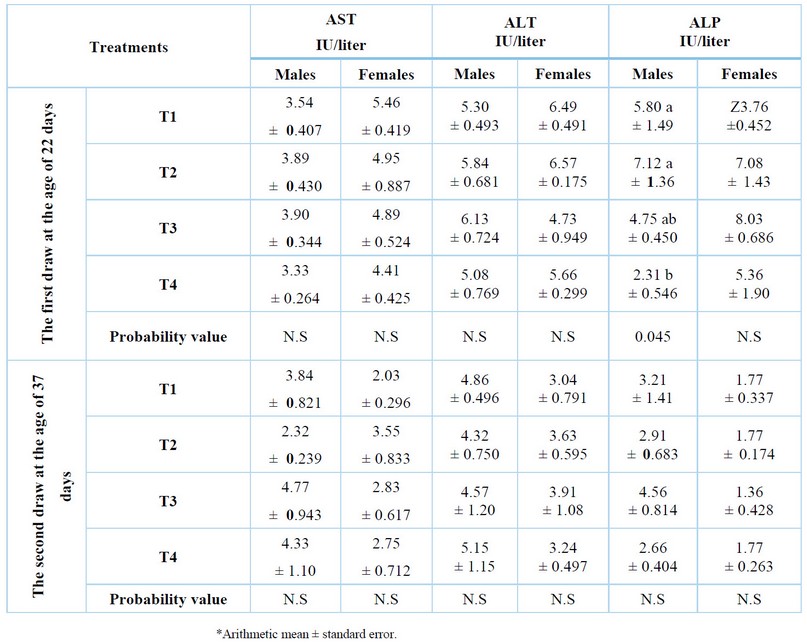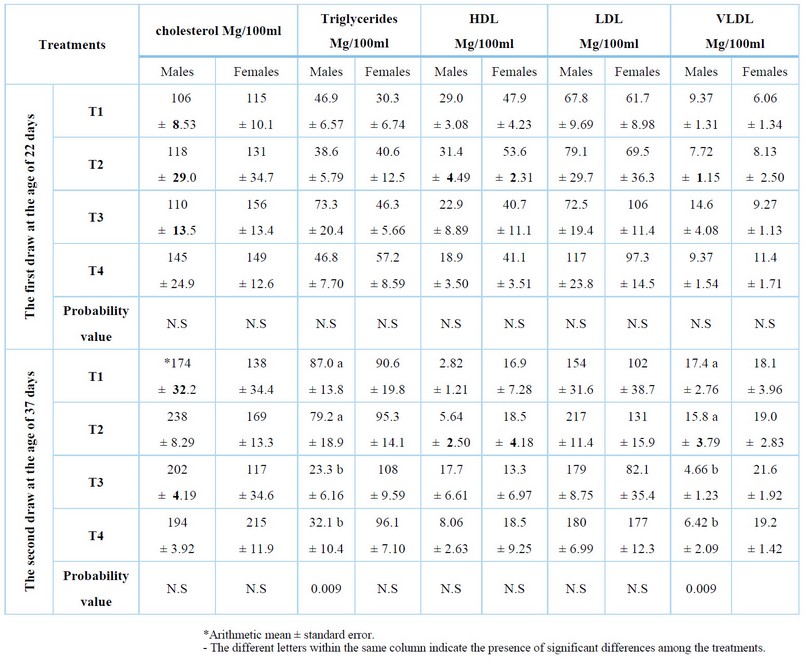2022.07.04.28
Files > Volume 7 > Vol 7 No 4 2022
Effect of a gradual increase in the intensity of lighting on the physiological performance of broilers
Ahmed A. Jassim *1, Waleed I. Al-Jugif 2
1 Department of Agriculture, Ministry of Agriculture, Al-Anbar, Iraq;
2 Department of Animal Production, College of Agriculture, University of Anbar, Iraq; [email protected]
* Correspondence: [email protected]
Available from: http://dx.doi.org/10.21931/RB/2022.07.04.28
ABSTRACT
Birds are exposed when the light is turned on by using the gradual increase of the light system. This study used 224 chicks (Ross 308) at one day old. Those chicks were randomly distributed into four treatments with four replicates for each treatment, i.e. (14 chicks/replicate). The treatments include the following: T1 the lighting program according to the guide for 308 ROSS company (Control Treatment), T2 the lighting program according to the guide with a gradual increase of lighting intensity every 20 minutes, T3 used the same method with an increase of lighting intensity every 40 minutes, T4 used lighting program with a gradual increase of lighting intensity every 60 minutes. The blood biochemical and hematological characteristics of 22 and 37 days of the age of chicks were studied. The results showed that females of T2 and T3 were significantly superior in blood sugar levels over the females of T1 and T4. Besides, it was observed that there was a significant decrease in the value of ALP enzyme in the blood of chicks males of all treatments compared with the control treatment. The H/L stress indicator was significantly decreased in T2, T3 and T4 compared with the control treatment. At the same time, there were no significant differences in other blood characteristics among all treatments. Finally, at the age of 37 days, it was noted that there was no significant difference among all blood characteristics at this age. It can be concluded that there were no significant effects of the gradual lighting intensity on the physiological performance of broilers. Still, at the period of 22 days, there was a reduction in stress levels, particularly H/L and very low-density lipoproteins. This experiment was conducted in the College of Agriculture, the University of Anbar's poultry fields for (37 days) the period from 18/10/2021 to 21/11/2021. the research was undertaken to reduce the effect of stress resulting from the sudden and high light intensity that birds are exposed to when the light is turned on by using the gradual increase of the light system. This study used 224 chicks (Ross 308) at one day old. Those chicks were randomly distributed into four treatments with four replicates for each treatment, i.e. (14 chicks/replicate). The treatments include the following: T1 the lighting program according to the guide for 308 ROSS company (Control Treatment), T2 the lighting program according to the guide with a gradual increase of lighting intensity every 20 minutes, T3 used the same method with an increase of lighting intensity every 40 minutes, T4 used lighting program with a gradual increase of lighting intensity every 60 minutes The blood biochemical of 22 and 37 days of the age of chicks were studied. The results showed that females of T2 and T3 were significantly superior in blood sugar levels over the females of T1 and T4. Besides, it was observed that there was a significant decrease in the value of ALP enzyme in the blood of chicks males of all treatments compared with the control treatment. The H/L ratio stress indicator was significantly decreased in T2, T3 and T4 compared with the control treatment.
In comparison, there were no significant differences in other blood characteristics among all treatments. Finally, at the age of 37 days, it was noted that there was no significant difference among all blood characteristics at this age. It can be concluded that there were no significant effects of the gradual lighting intensity on the physiological performance of broilers. Still, at 22 days, there was a reduction in stress levels, particularly H/L ratio and very low-density lipoproteins.
Keywords: Broiler ; ROSS 308 ; Light Intensity ; Lux; Blood characteristics
INTRODUCTION
Lighting is an essential element in broiler production because it is the most crucial external factor since it controls physiological and behavioral processes in birds 1. Therefore, light management has emerged as one of the critical management tools for broiler 2. The effect of light on the pineal gland helps synchronize the circadian rhythm and inhibits melatonin secretion 3. Light intensity has a strong influence on the behavior of broilers in general. General bright light will increase activity while decreasing the intensity effects on controlling the aggressive actions that lead to predation 4.
The use of intermittent lighting programs positively affects the immunity of broilers as it affects the circadian rhythms, which in turn regulates melatonin production and thus improves the general health of birds. The effect of light on the pineal gland helps synchronize the circadian rhythm and inhibits the secretion of melatonin 5. The blocking of light is regarded as a form of moderate feeding restriction, as these programs work on reducing the early growth rate as well as reducing feed consumption. It also improves the feed conversion factor and reduces electrical energy costs, as lighting is a critical environmental and administrative factor affecting broiler flocks' performance, welfare and production 6. Continuous lighting exposure of birds leads to a severe decrease in the production of the melatonin hormone, which negatively affects the health and well-being of broilers as a result of stress. Many studies refer to the increase of stress indicators when using 22-23 hours lighting systems besides using high light intensity which causes a decrease in the level of the melatonin hormone as well as the stress hormone that leads to weakening the immunity of birds and deterioration their physiological state 7, 8.
Therefore, this study aimed to lessen the stress a bird experiences every day when the lights are turned on for the first time to an unexpectedly high intensity.
MATERIALS AND METHODS
The experiment was conducted in the poultry field of the Department of Animal Production at the College of Agriculture, University of Anbar. The experiment period of 37 days in the period from 18/10/2021 to 23/11/2021. The experiment was assigned to the batteries hall, with four batteries and four floors of each local battery. The dimensions of each floor were 120 x 1 m. equipped with lighting. The lighting program uses 20 hours of light and 4 hours of darkness, according to the ROSS 308 company manual. An electric device was used to grade the intensity of the homemade lighting, as it works on 220 volts and a frequency of 50
Hz. It also works on a gradual light intensity with four graded degrees (4 lux, 8 lux, 14 lux and 20 lux), respectively. Accordingly, this device can control the intensity times through its timer counters. A "Luxmeter" is a device used to measure the intensity of lighting.
Unsexed broiler chicks (ROSS 308) one-day-old were used in this experiment. Those chicks were brought from the Al-Waha modern hatchery in Kubaisa to the west of Anbar province.
In this study, 224 unsexed chicks of the Ross 308 strain were used, with an average weight of 40 g. The chicks were distributed randomly into four experimental treatments with four replicates of each treatment (14 birds/replicate).
The four treatments were the following:
T1: - Lighting program according to the guide of 308 ROSS (control treatment).
T2: - Lighting program according to 308 ROSS company guide with the gradual increase in the lighting intensity every 20 minutes.
T3: - Lighting program according to 308 ROSS company guide with the gradual increase in the lighting intensity every 40 minutes.
T4: - Lighting program according to 308 ROSS company guide with the gradual increase in the lighting intensity every 60 minutes.
Three types of feeds were given during the period of the experiment; these types were; 1. (starter feed) from the age of 1 day to day 14, 2. (grower feed) from day 14 to day 27, 3. (finisher feed) from day 27 to the end of the experiment 37 days, according to the chemical composition of the feeding guide as stated in (13). Blood was collected from birds at 22 days of age and 37 days of age. The studied features include the following: heterophile and lymphocytes blood cells (heterophile/lymphocytes, H/L ratio ), packed cell volume (PCV), glucose level, total protein, albumin, globulin, aspartate aminotransferase (AST), alanine aminotransferase (ALT), alkaline phosphatase (ALP), cholesterol, triglycerides,high-density lipoprotein (HDL), low-density lipoprotein (LDL) and very low-density lipoprotein (VLDL) in broiler blood plasma. 9,10,11,12,13,14
The results of the study were analyzed using Complete Random Design (CRD) to investigate the effect of different treatments on the studied features as well as using Duncan's multivariate test (7), and the differences between the means at the mean level of 0.05 and 0.01 were examined using the statistical analysis system (SAS, 2002).15
RESULTS
Heterophile and lymphocytes blood cells, H/L ratio, and PCV in broiler blood
The results in Table 1 show the effect of lighting intensity on heterophile, lymphocytes H/L ratio, and PCV of broiler chicks. Lymphocytes (H/L ratio), which represents the stress level of birds; thus, T1 (P <0.05) records the highest value with a significant difference among other treatments. Likewise, it was observed that there were differences among treatments in the number of heterogeneous cells, where the two treatments, T1 and T4, outperform the other two treatments T2 and treatment T2 was superior to treatment T3 at the age of 22 days (first blood draw). Regarding the lymphocytes, the results show that treatment T3 has a significant superiority over other treatments, i.e., T1, T2 and T4.On the other hand, treatment T2 was superior to treatment T1, which was overtaken by treatment T1 at the age of 22 days (first draw).
As for the results of the H/L ratio, it was observed that there were significant differences among the treatments, where treatment T1 outperforms all other treatments, T2, T3, and T4. Whereas treatment T4 overtakes the two treatments, i.e., T2 and T3, at 22 days (first draw). As concerns PCV, there were no significant differences among the treatments for both males and females at the age of (22 days).
As regards the second draw, which was at the age of 37 days, it was noted that there was no significant difference among the treatments in all the studied characteristics shown in table No. (1) included heterogeneous blood cells, lymphocytes, H/L ratio and PCV (for both sexes, males and females).
Accordingly, the results of this study agree with 16 as they use incandescent light (60 watts) as a control treatment, while the other treatments like; LED light, red light, blue light, green light, white light, and mixed light on Ross 308 broilers show that there was no significant difference of the packed cell volume (PCV henceforth ) and the percentage of heterophile cells (H/L) when compared with the control treatment. The results of this study also agree with 17 when the light intensity of 5 lux and 20 lux was used for Coop broilers as it was not considerably affected the PCV and ousheterophil/lymphocyte (H/L) ratio among experiment parameters.
The H/L ratio (T2, T3, T4 ) decrease in all the experimental treatments compared with the control treatment may be due to the reduction of stress to which the birds were exposed when the lights were turned on at a high intensity. Elevation of the H/L ratio value in birds directly exposed to high light intensity compared to birds exposed to a gradual light intensity on white blood cells and the immune system.

Table 1. The effect of a gradual increase in the intensity of lighting on some blood characteristics
Glucose Level, total protein, albumin and globulin in broiler blood plasma
The results in table 2 show the effect of the gradient in the intensity of lighting on the glucose levels, total protein, albumin and globulin in the blood plasma of male and female broilers. No significant differences were observed between treatments for males in the level of glucose in the blood plasma. At the same time, it was noted that treatment T2 (P< 0.01) was superior to treatments T1 and T4, and it doesn't differ significantly from the between treatments for females at the age of 22 days.
As far as the total protein was concerned, no significant differences were perceived between the treatments of both males and females at 22 days (the first draw). Concerning albumin, there was a considerable decrease in males in all the treatments of the experiment compared to the control treatment. In females, no significant differences were observed among all treatments at the age of 22 days (first draw). Likewise, for globulin, there were also no significant differences between the treatments of both males and females at the age of 22 days (the first draw). As for the second draw, which was at the age of 37 days, it was observed that there was no significant difference among all treatments in all the studied features shown in the table. No. (2), i.e., glucose, total protein, albumin, globulin, and for both sexes (males and females).
The reason that there was no effect of lighting intensity when increasing the age of the bird to the age of 37 days was the ability of the bird to consume large quantities of feed when providing light, which removes the effect of lack of light that prevents the availability or consumption of food in times of darkness. In line with 18, the results of the study agree that when using two types of lighting, the first was bright and the second was dim when raising Roos 308 broilers; it does not significantly affect glucose, cholesterol and total protein among all experiment treatments when studying these characteristics of the broiler at the age of 37 days.

Table 2. Effect of a gradual increase in the intensity of lighting on some characteristics of blood plasma
Liver enzymes in broiler blood plasma
The results summarized in Table 3 show us the effect of light intensity on AST, ALT and ALP for males and females of broilers. There were no significant differences among treatments in both males and females for AST and ALT enzymes. As for ALP, the results of males were the highest (P <0.05) among the T1 and T2 and on treatment T4, and it does not significantly differ from treatment T3. Concerning the results of females, no significant differences were recorded among the treatments at 22 days.
For the second draw at 37 days, there were no significant differences among all treatments in all the studied characteristics in table No. (3), e.g., AST, ALT and ALP enzymes for both sexes (males and females).

Table 3. The effect of the gradient in light intensity on liver enzymes in broiler blood plasma
The results of this study go in line with 17 who used 5 lux and 20 lux for Coop broilers which was not significantly affected by the enzyme Aspartate Amino Transfers (AST) and Alkaline phosphatase (ALP) in the experimental treatments. The results of the study also agree with 19 who use light intensity either bright (20 lux from day 1 to day 42) or (dim 5 lux from day 1 to day 8, 2.5 lux from day 9 to 15 day, and 1.25 Lux from 16 days to 42). Ross308 broilers did not significantly affect the enzyme Aspartate Amino transfers (AST) among the experimental treatments.
Lipid profile in broiler blood plasma
The results summarized in Table 4 refer to the effect of light intensity on cholesterol, triglycerides, HDL, LDL, and VLDL; thus, there were no significant differences among all the treatments of the given features for males and females at the age of 22 days. As for the second draw at 37 days, the results indicate no significant differences among the different treatments in cholesterol, HDL and LDL for males and females. Regarding triglycerides, it was noticed that the two treatments and T2 were higher than the two treatments and T4 for males, while females had no significant differences among the treatments.
Moreover, it was observed that the treatment of T1 and T2 in the value of VLDL have higher superiority over the other two treatments, T3 and T4, for males. In contrast, females have no significant differences among the treatments.

Table 4. The effect of the gradient in the lighting intensity on the lipid profile in the broiler's blood plasma
Thus, the fat values in the blood plasma of birds under the experiment indicate a highly significant decrease in treatment T3 and 4T, respectively, in the two features, i.e., triglycerides and very low-density lipoproteins. These two features were considered bad cholesterol, which causes strokes. They were increased significantly in T1 and. This increase may be due to the decrease in birds' stress caused by the high light intensity, as shown in table No. (1) which shows the H/L ratio value, achieving a good health condition that leads to very low-density lipoproteins.
The outcomes of the study agree with 20, who use two types of light intensity (5 lux, 50 lux) when breeding Roos 308 broilers, as they do not significantly affect cholesterol, high-density lipids (HDL) and low-density lipids ( LDL) among the experiment parameters.
The significant superiority in blood images may be attributed to the fact that light allows birds to settle down and synchronizes many functions, including body temperature and metabolic steps that facilitate feeding and digestion. Likewise, light stimulates the secretion of patterns of several hormones that significantly control growth, maturation and 21. The research concluded a significant decrease in stress values, especially at 22 days. These values were H/L ratio and very low-density lipoproteins, which indicates a reduction in the stressful effect of the direct intensity of light on birds when the lights were turned on using the system of gradual increase in the power of light on the physiological performance of broilers (Ross 308).
CONCLUSIONS
This study concluded a significant decrease in stress values, especially at 22 days. These values were H/L and very low-density lipoproteins, which indicates a reduction in the stressful effect of the direct intensity of light on birds when the lights were turned on using the system of gradual increase in the intensity of light on the physiological performance of broilers (Ross 308).
REFERENCES
1. Raccoursier–Frost, M . Effect of light intensity on production parameters and feeding behavior of broilers, (Thesis and Dissertations.Master of Science in Poultry Science).Department of Poultry Science.University of Arkansas. Arkansas, USA.2016.
· Pal, P., Dey, D., Sharma, B., Choudhary, S., Sahu, J., Kumar, S., &, S. Ghosh . Effect of light management in broiler production : A review Effect of light management in broiler production : A review," J. Entomol. Zool. 2019. 7(3):437-441.
2. Schwean-Lardner, K., Vermette, C., Leis, M., & H. L. Classen. Basing turkey lighting programs on broiler research: a good idea? A comparison of 18 daylength effects on broiler and turkey welfare.Animals. 2016. 6(5): 16-1.
· Zhao, R. X., Cai, C. H., Wang, P., Zheng, L., Wang, J. S., Li, K. X., ... &, K. Y. Wang. Effect of night light regimen on growth performance, antioxidant status and health of broiler chickens from 1 to 21 days of age. Asian-Australasian Journal of Animal Sciences. 2019 . 32(6): 904–911.
3. Beski, S. S. M., M'Sadeq, S. A., Hussein, S. M., & A. L. Mahmod. Performance and physiological responses of broiler chickens to dietary combination of yeast and medical plants.Iraqi journal of agricultural sciences. 2021. 52(5): 1117-1125.
· Olanrewaju, H. A., Miller, W. W., Maslin, W. R., Collier, S. D., Purswell, J. L., & S. L. Branton . Effects of light sources and intensity on broilers grown to heavy weights. Part 1: Growth performance, carcass characteristics, and welfare indices. Poultry Science. 2016. 95(4):727-735.
4. Tan, D. X., Xu, B., Zhou, X., &, R. J. Reiter . Pineal calcification, melatonin production, aging, associated health consequences and rejuvenation of the pineal gland.Molecules. 2018. 23(2): 1 -31.
· Ghanima, M. M. A., Abd El-Hack, M. E., Abougabal, M. S., Taha, A. E., Tufarelli, V., Laudadio, V., & M. A. Naiel . Growth, carcass traits, immunity and oxidative status of broilers exposed to continuous or intermittent lighting programs. Animal Bioscience. 2021 . 34(7): 1243–1252.
5. Archer, R. K. Haematological techniques for use on animals. Haematological techniques for use on animals. 1965 .
· Burton , R.R., and C.W.Guion , The differential leucocyte blood count . Its precission and individuality in the chicken . poultry sci . 1968 . 47 : 1945-1949.
6. Friedewald, W. T., Levy, R. I., & Fredrickson, D. S. Estimation of the concentration of low-density lipoprotein cholesterol in plasma, without use of the preparative ultracentrifuge. Clinical chemistry, 1972 . 18(6), 499-502.
· Grundy, S. M., Cleeman, J. I., Merz, C. N. B., Brewer, H. B., Clark, L. T., Hunninghake, D. B., ... & Stone, N. J. Implications of recent clinical trials for the national cholesterol education program adult treatment panel III guidelines. Circulation, 2004. 110(2), 227-239.
7. Reitman, S. and S. Frankel.. A colorimetric method for the determination of serum glutamic oxalacetic and glutamic pyruvic transaminases Amer. J. Clin. Pathol. 1957 . 28: 56- 63.
· Asatoor, A. M., & King, E. J. Simplified colorimetric blood sugar method. The Biochemical Journal, 1954 . 56(325th Meeting), xliv.
8. Duncan, D. B. Multiple range and multiple F tests.Biometrics . 1955 .11(1): 1-42 .
· Abdelazeem, A. F. Productive and physiological response of broiler chickens exposed to the different colored light-emitting diode and reared under different stocking densities. Egyptian Poultry Science Journal. 2019 . 38(4): 1243-1264.
9. Mohamed, R., Abou-Elnaga, A., Ghazy, E., Mohammed, H., Shukry, M., Farrag, F., & O. Bahattab. Effect of different monochromatic LED light colour and intensity on growth performance, physiological response and fear reactions in broiler chicken.Italian Journal of Animal Science. 2020 . 19(1): 1099-1107.
· Fidan, E. D., Nazligül, A., TÜRKYILMAZ, M. K., Karaarslan, S., & M. Kaya . Effects of photoperiod length and light intensity on performance, carcass characteristics and heterophil to lymphocyte ratio in broilers. KafkasUniversitesiVeterinerFakultesiDergisi. 2017 . 23(1): 39-45.
10. DereliFidan, E., Nazligul, A., Türkyılmaz, M. K., ÜnübolAypak, S., SevilKilimci, F., Karaarslan, S., & M. Kaya. Phenotypic Correlations in Broiler Breast Meat Quality and some Welfare Criteria: Implications of Photoperiod Length and Light Intensity. Iranian Journal of Applied Animal Science. 2018 . 8(3): 511-518.
· Gharahveysi, S., Irani, M., Kenari, T. A., & K. I. Mahmud . Effects of colour and intensity of artificial light produced by incandescent bulbs on the performance traits, thyroid hormones, and blood metabolites of broiler chickens.Italian Journal of Animal Science. 2020 . 19(1): 1-7.
11. Patel, S. J., Patel, A. S., Patel, M. D., & J. H. Patel . Significance of light in poultry production: a review. Work . 2016 . 5(4): 1154-1160 .
Received: August 25, 2022 / Accepted: October 12, 2022 / Published:15 November 2022
Citation: Jassim A A, Al-Jugif WI. Effect of a gradual increase in the intensity of lighting on the physiological performance of broilers.Revis Bionatura 2022;7(4) 28. http://dx.doi.org/10.21931/RB/2022.07.04.28
